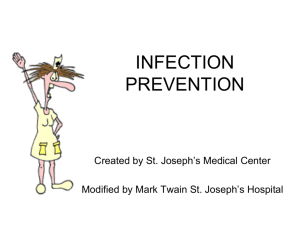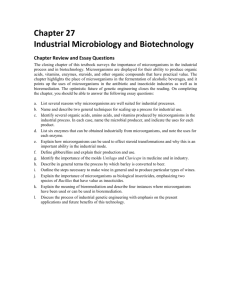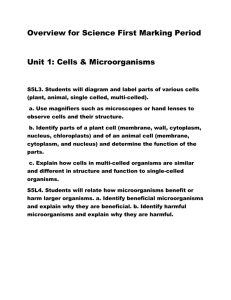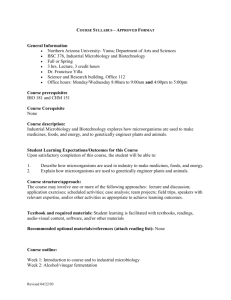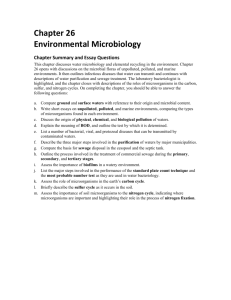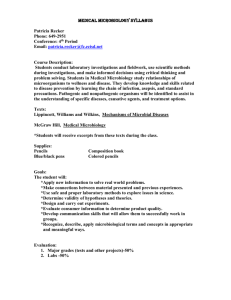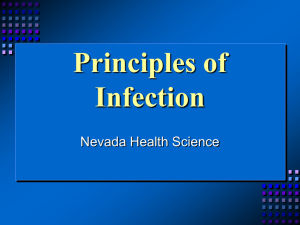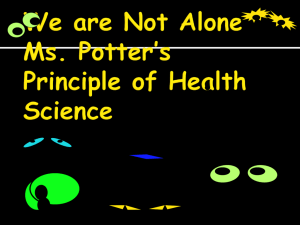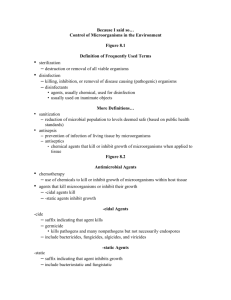Microbiology 205 – Spring 2010 Final Exam Study Guide
advertisement
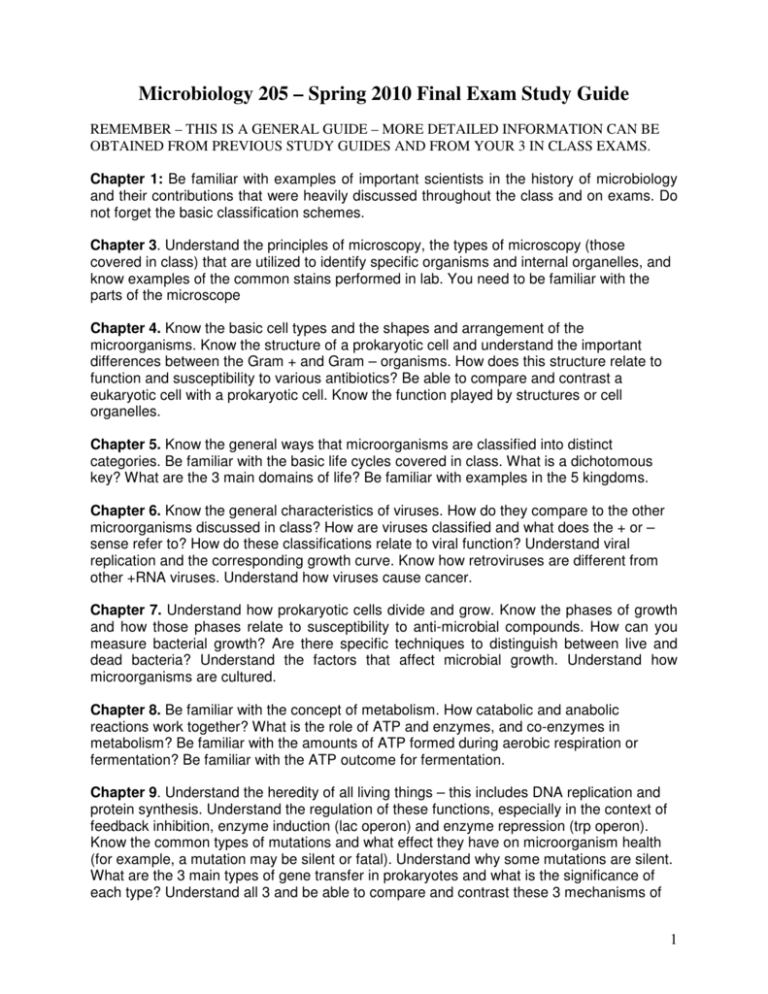
Microbiology 205 – Spring 2010 Final Exam Study Guide REMEMBER – THIS IS A GENERAL GUIDE – MORE DETAILED INFORMATION CAN BE OBTAINED FROM PREVIOUS STUDY GUIDES AND FROM YOUR 3 IN CLASS EXAMS. Chapter 1: Be familiar with examples of important scientists in the history of microbiology and their contributions that were heavily discussed throughout the class and on exams. Do not forget the basic classification schemes. Chapter 3. Understand the principles of microscopy, the types of microscopy (those covered in class) that are utilized to identify specific organisms and internal organelles, and know examples of the common stains performed in lab. You need to be familiar with the parts of the microscope Chapter 4. Know the basic cell types and the shapes and arrangement of the microorganisms. Know the structure of a prokaryotic cell and understand the important differences between the Gram + and Gram – organisms. How does this structure relate to function and susceptibility to various antibiotics? Be able to compare and contrast a eukaryotic cell with a prokaryotic cell. Know the function played by structures or cell organelles. Chapter 5. Know the general ways that microorganisms are classified into distinct categories. Be familiar with the basic life cycles covered in class. What is a dichotomous key? What are the 3 main domains of life? Be familiar with examples in the 5 kingdoms. Chapter 6. Know the general characteristics of viruses. How do they compare to the other microorganisms discussed in class? How are viruses classified and what does the + or – sense refer to? How do these classifications relate to viral function? Understand viral replication and the corresponding growth curve. Know how retroviruses are different from other +RNA viruses. Understand how viruses cause cancer. Chapter 7. Understand how prokaryotic cells divide and grow. Know the phases of growth and how those phases relate to susceptibility to anti-microbial compounds. How can you measure bacterial growth? Are there specific techniques to distinguish between live and dead bacteria? Understand the factors that affect microbial growth. Understand how microorganisms are cultured. Chapter 8. Be familiar with the concept of metabolism. How catabolic and anabolic reactions work together? What is the role of ATP and enzymes, and co-enzymes in metabolism? Be familiar with the amounts of ATP formed during aerobic respiration or fermentation? Be familiar with the ATP outcome for fermentation. Chapter 9. Understand the heredity of all living things – this includes DNA replication and protein synthesis. Understand the regulation of these functions, especially in the context of feedback inhibition, enzyme induction (lac operon) and enzyme repression (trp operon). Know the common types of mutations and what effect they have on microorganism health (for example, a mutation may be silent or fatal). Understand why some mutations are silent. What are the 3 main types of gene transfer in prokaryotes and what is the significance of each type? Understand all 3 and be able to compare and contrast these 3 mechanisms of 1 gene transfer. Understand what plasmids are and know specific examples of plasmids that were discussed in class. What is a prophage? What is lysogeny? Chapter 10. Be familiar with basic DNA techniques, what are good cloning hosts?, what do you need for selection?, Be familiar with PCR and its application, Be familiar with gene therapy. Chapter 11.Understand the general terms sterilization and disinfection and how they relate to the control of microbial growth. What does it mean to be bacteriostatic? Bacteriocidal? Antiseptic? What is the phenol coefficient? Chapter 12. Understand the important concepts of antimicrobial chemotherapy. What is selective toxicity and why is it important? What are the common modes of action of antimicrobial agents and how do microorganisms avoid/evade these modes of action? What is a beta-lactam ring and why is it important? What is beta-lactamase? How do microorganisms develop resistance to antimicrobial agents? Know specific examples of antimicrobial agents as they relate to the 5 main modes of action. Be able to apply this knowledge to the treatment of specific infections discussed in class. Chapter 13. Understand the terms Infection, Infectious, Disease, Pathogen, Pathogenecity, Virulence. Understand the importance of the normal flora. Understand how microorganisms cause disease and know the stages of infectious disease. What is an acute disease? Chronic disease? Be familiar with the transmission of a disease: (provide examples and be able to match them: Contact (direct, indirect, and droplet transmission), Vehicle (airborne, waterborne, foodborne), Vector (mechanical and biological). Understand what nosocomial infections are and why they occur. Chapter 14. Non-specific immunity 1. General knowledge of what non-specific immunity means. How does it work to protect us against infection? What are the first and second lines of defense? 2. Know the relative effectiveness of the primary physical and chemical barriers to infection (skin, mucous membranes, lysozyme, etc) 4. Understand the role played by the components of the second line of defense: a) What is phagocytosis? Why is it important? What are the most important phagocytic cells? How do phagocytes can kill microorganisms? Be able to identify how organisms can avoid destruction by phagocytes. Describe the physical process of phagocytosis of a bacterial cell by a macrophage. Know what types of cells are considered mobile phagocytes. Under this section you need to be familiar with the process of hematopoiesis. What are the two main lineages? What cells are produced from each lineage? What is the function of the lymphatic system? Provide ONE example of a primary and a secondary lymphoid organ. b) What is fever? How can fever be beneficial/deleterious to microorganisms? How is fever triggered? c) What is complement? How does complement work to protect us from infection? Know the 3 main pathways that activate the complement cascade. What are the benefits of complement activation? What are the major components that were discussed in class and what are their functions? 2 d) What is inflammation? How is inflammation important during infection? What triggers inflammation? Define a chemotactic factor and indicate what types of human cells that would be drawn to a site of an infection by chemotactic factors (diapedesis). Outline the events that occur in an inflammatory response including cell recruitment. Be able to give a generalized explanation as to the various protective effects associated with an inflammatory response in a focus of infection. e) Define the role of interferons (alpha, beta) during viral infections. Can these small proteins be used for human treatment? Know how each is important in fighting infections. 3

